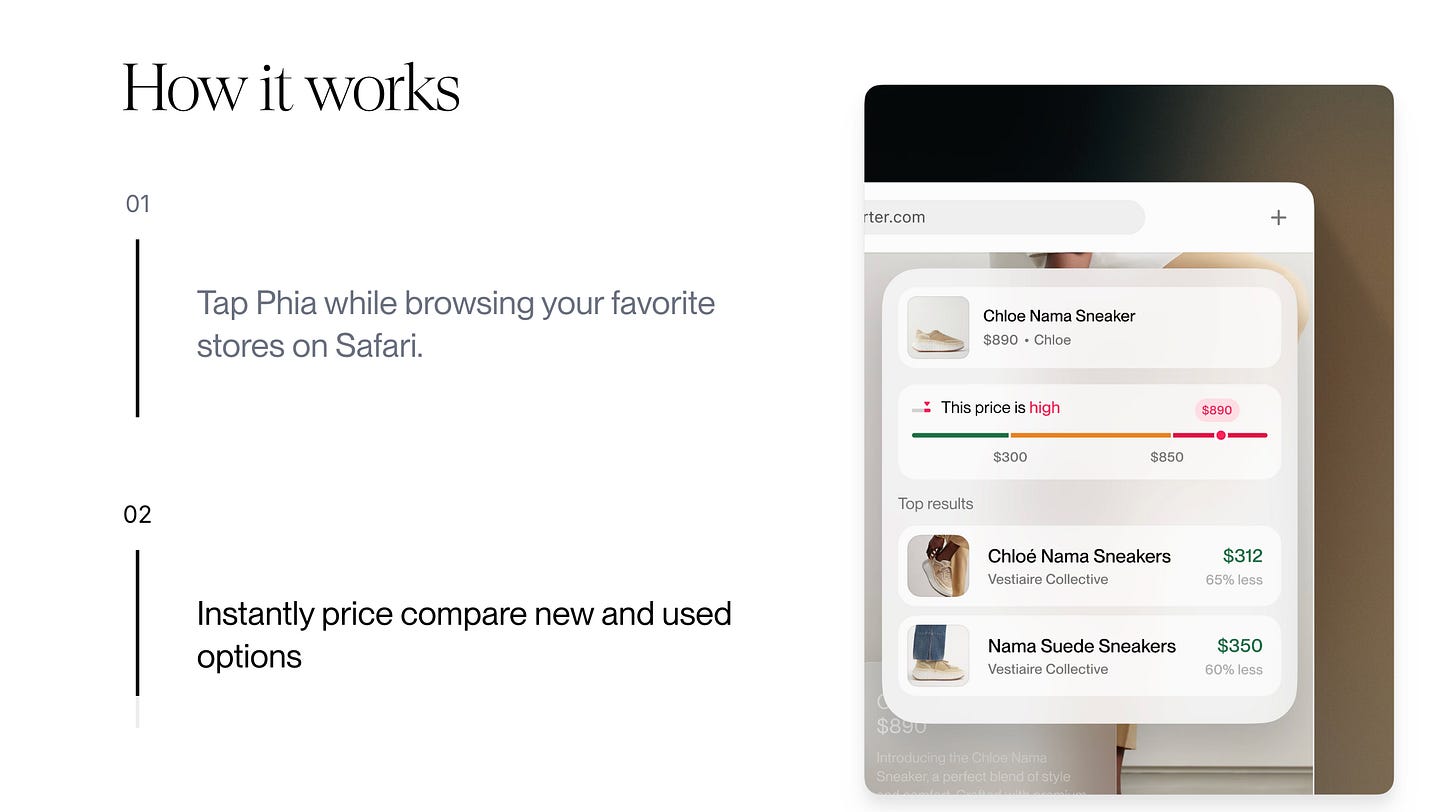Agentic Commerce: When AI Does the Shopping for You
Malls ➡️ Websites ➡️ Apps ➡️ Agents
Weekly writing about how technology and people intersect. By day, I’m building Daybreak to partner with early-stage founders. By night, I’m writing Digital Native about market trends and startup opportunities.
If you haven’t subscribed, join 70,000+ weekly readers by subscribing here:
Hey Everyone 👋,
Next week is New York Tech Week. We at Daybreak are co-hosting an event on Tuesday evening with our friends at Bling. Stop by if you like tech and tacos! It would be great to meet in person—you can RSVP here.
With that, let’s talk agentic commerce…
Agentic Commerce: When AI Does the Shopping for You
One of the earliest recorded forms of commerce was cattle trade around 10,000 B.C.
Cattle had a fixed value and were exchanged for goods and services. The Latin word for money, pecunia, actually comes from pecus, the Latin word for cattle. Nowadays, commerce involves less cattle and more Apple Pay (more convenient, it turns out), but commerce continues to power the economy.
About once a year I like to write a piece about what’s happening in commerce; recent examples:
The Wild West of E-Commerce (2023)
These pieces usually talk about how commerce has evolved from cattle to credit cards, and where we’re heading next. Last year, for instance, we talked about Ozempic, overstock, creator brands, and sustainable fashion.
I often include some version of this chart, too:
That’s because this chart best summarizes the shifts in commerce over the past 30 years. Offline to online.
The big disruption was happening in where we were shopping. First we were shopping in malls; then we were shopping on websites; then we were shopping in apps. But each progression still hinged on a core principle: that you were the one doing the shopping.
The next overhaul in commerce, is my mind, isn’t a change in where we shop, but in who is doing the shopping.
Today I want to talk about agentic commerce. I’m hearing this term more in Pre-Seed and Seed pitches, and BCV’s Scott Friend wrote a good piece last fall arguing that agentic commerce is the natural “third wave” after e-commerce (Wave 1, ushered in with the internet) and mobile (Wave 2, ushered in with the iPhone).
It’s interesting to me to question what a future version of the chart above might look like. A 2025 to 2050 version might look something like this:
Let’s explore what this could look like.
Delegation, Delegation, Delegation
With the rise of AI agents, people are increasingly offloading the stuff they don’t want to do. At work, this means notes and memos and spreadsheets. At home, this means utility-oriented shopping.
We’ll start delegating more and more to autonomous agents that understand our preferences and our constraints. What do we mean by that?
What Agentic Commerce Will Look Like
In a few years, you might be sleeping while your AI agent is shopping for your mom’s birthday gift. Your agent finds the gift, negotiates the price, and schedules delivery.
This sounds a little uncomfortable: shouldn’t we be the ones putting in the time and effort for mom’s gift? The more likely winning product will build in a bit of friction, inserting moments of human control—moments of delegation. You might wake up to three options for mom’s gift; over your morning coffee, you select one, then instruct your agent to execute the purchase and arrange delivery.
If we take a step back, I would broadly separate shopping into two categories: utility shopping and emotional shopping. Utility shopping is buying the stuff we have to—milk and light bulbs and trash bags. Emotional shopping is buying the stuff we want to—handbags and candles and artwork.
For future products focused on utility shopping, the right KPI might be minimizing time spent. We don’t want people spending an hour a day on our site. We want you to get in and get out! Amazon is mostly in this category: the checkout experience painstakingly removes friction so that you can order paper towels in just a few seconds. This is why Amazon put a patent on 1-click checkout.
For future products focused on emotional shopping, the right KPI might be maximizing time spent. Here, we want people browsing and perusing and discovering new stuff. The best old-school example might be the shopping mall. A more recent example could be something like LTK. A company like Pinterest should have dominated this form of shopping, but never really nailed commerce.
When I think about AI innovation in shopping, I think about utility vs. emotional.
On the utility side, we’ll have agents that do the dirty work. They hunt for good deals. They re-order our toilet paper. They know mom’s birthday is coming up, and they’re ready to go with a shortlist of gift ideas.
A recent example of innovation in commerce is Phia, which just came out of stealth. Phia lets you find the best prices online, ensuring you’re getting the best deal on anything you buy. It’s easy to see an agentic future here: (1) tell Phia what you want, (2) set a price, (3) wait for Phia to buy it for you. “I want this Todd Snyder suede jacket, but only if you can find it under $500.” A few days later, I might get a notification that my Phia agent bought the jacket and it’s on its way.
It’s also easy to see agentic commerce invading other utility use cases:
“Please change my flight back to New York to Tuesday and book a window seat.”
“Please book me a haircut with Tanya next Thursday after 4pm.”
“Please send a bottle of wine around $50 to Brian with a thank you note.”
Yes, it’s important we still say please and thank you!
The emotional side of shopping, in my view, will be less agent-centric.
Here, people like shopping, and they don’t want to delegate. Instead, LLMs can better recommend products. AI = personalization. This is where conversational commerce will dominate: we’ll have a destination where we can type “I need colorful pastels and linen pants for summer that match my style” and immediately get tailored recommendations. That’s the $100B idea waiting in LLM-powered discovery-driven commerce. There still may be agents here—personal shoppers that give us options to choose from—but the product design for these shopping experiences will be more human-centric than agent-centric.
I expect that agentic commerce will most infiltrate forms of shopping that require cognitive load—a fancy way of saying, the tedious and sometimes hard stuff we don’t like doing. This is mostly utility-shopping. Examples of types of agents we’ll see:
Price comparison agents constantly scanning in the background for price drops on items you care about (like in the Phia example above)
Negotiation agents that haggle for you on marketplaces (so that you don’t have to send 26 messages back-and-forth on Poshmark or Facebook Marketplace)
Taste agents, trained on your closet data, that recommend products tailored to your specific style, wishlist, and browsing behavior (this where lines will blur between utility and emotional shopping)
In 10 years, I think that some high portion (10%? 20%?) of transactions will be conducted by agents.
Agentic Commerce Infrastructure
Naturally, the entire retail landscape needs to be overhauled for agents. Right now, brands and retailers have shopping sites built for humans (shocker!), but what happens when a high percentage of transactions are agents?
Agents require accessible APIs, structured product data, agent-friendly checkout. Websites and mobile apps need to be readable by AI. You’d better make sure your checkout flow can talk to an AI agent, or you’re missing out on big dollars.
You might ask your agent, “Find a blouse under $100, wrinkle-resistant, with good sustainability ratings.” Today the site that wins is the one that’s most consumer-friendly; sites are optimized for visual consumption. Tomorrow the site that wins might be the site with the best metadata that AI can parse.
We wrote earlier this year about discovering products in AI search (How AI Changes Customer Acquisition). That piece mostly centered on humans discovering brands through ChatGPT, Perplexity, and so on. But what about when agents are doing the discovering? The playbook again changes, on everything from customer agent acquisition to checkout.
Final Thoughts: The Next Frontier
The jury’s out on how much further e-commerce will penetrate US retail. Penetration is still creeping up, sure, but we’re nowhere near the penetration of other countries.
Why is this? A number of reasons. Taking China as an example:
China had less entrenched offline retail; the US has had strong brick-and-mortar incumbents (Walmart, Target, and so on).
China skipped the PC era, with many consumers coming online for the first time through smartphones; this made mobile commerce the default. The US has always had a strong legacy of desktop-first (and brick-and-mortar) browsing.
US logistics evolved around physical retail, while China developed networks tailored for e-commerce from the ground up.
China has super apps like WeChat, Alipay, and Taobao that blend social and commerce, while the US is more fragmented. Amazon dominates commerce but isn’t a social or payments company.
Geography: the US is more spread out and car ownership is higher, which lends itself to offline commerce; China’s dense cities, meanwhile, lend themselves to e-commerce.
US retail will never be as online penetrated as Chinese retail. The offline-to-online shift still has room to run, yes, but growth is drying up. So where will growth come from? The human-to-agent shift. What offline-to-online was in the 1995-2025 period, human-to-agent will be in the 2025-2055 period.
It’ll be interesting to see how different customers adopt agentic commerce. How will US consumers behave compared to Chinese consumers, for instance? How do privacy concerns influence agent usage? Which countries will lean most into shopping agents? Which types of shopping lean most toward agentic?
I’m also interested in the hard-to-predict derivative effects. Who could have predicted that mobile would lead to direct-to-consumer brands, which would lead to 175 (!) DTC mattress brands in 2019? What’s the ‘bed-in-a-box’ trend of the coming years?
The entire e-comm world is about to get an overhaul. We’ve all been shopping for as long as we can remember—in different places, sure, but we’ve been the ones shopping. That’s about to change.
As a final note: my friends at General Catalyst are hosting an AI + commerce hackathon on June 14th in NYC. If you’re interested, check out the blurb below and apply to join. I’m planning to stop by, and hope to see you there! 🛍️
Join General Catalyst, Stripe, and Amazon for a one-day hackathon exploring the cutting edge of AI and commerce on June 14th in NYC! We're at the start of a new paradigm where autonomous agents reshape economic activity and introduce novel challenges in payments, personalization, and user experience.
This hackathon will bring together builders to prototype tools, infrastructure, and experiences that power the future of AI-driven commerce. There will be prizes, food, and great company!
Apply here to join!
Thanks for reading! Subscribe here to receive Digital Native in your inbox each week:












